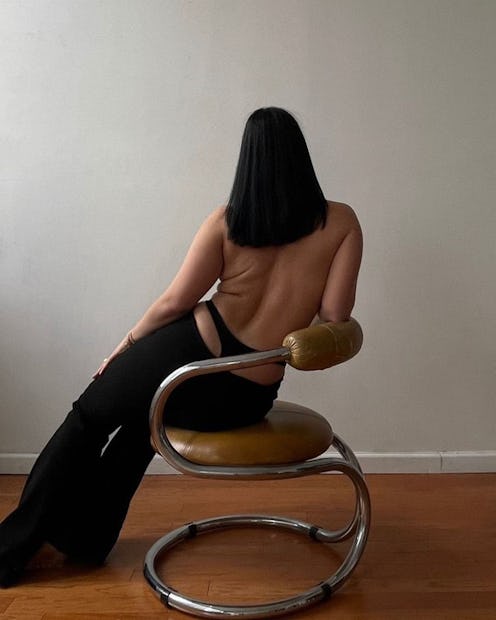(Trends)
A New Wave Of Designers Is Making Fashion Sensual Again
The significance of skin-baring trends.

There are about as many different definitions of “sexy” as there are people on this planet, but a sensual outfit still brings some obvious visual cues to mind. They include short hemlines, body-hugging fits, low-cut necklines, and corsetry (or other lingerie-inspired pieces). It just so happens that those exact silhouettes are also currently dominating fashion trends and spearheaded by a new generation of designers centering sensuality. They’re seen in creative cutout placements in the collections for Dion Lee or Marcia, bustier tops by Christopher John Rogers and With Jean, and sheer, artful creations by Supriya Lele and Kim Shui. And according to experts, it’s no coincidence these specific expressions of style and sexuality are heightened in the summer of 2021.
In an effort to dissect why present-day fashion trends define the moment, it’s always important to first look back. Though entirely optional to follow, the trend cycle tends to represent a swinging of a pendulum. For example, Alessandro Michele’s Gucci maximalism followed the era of Phoebe Philo’s Celine minimalism. The prominence of classic and powerful suiting around 2015 is sandwiched between the athleisure boom of the early 2010s and romantic, pastoral cottagecore of 2018. Now, silhouettes that celebrate and intentionally showcase the human form feel like a departure from what’s preceded it, too.
For designer Kari Fry of Los Angeles-based Subsurface, today’s daring silhouettes are still influenced by fashion from the past. Fry’s label has gained recognition for its slinky and sustainably made designs, including the Hostess Pants, a tailored trouser with a thong-shaped waistband. “I made the first prototype in my bedroom in 2019, and it’s been fun to see it gain traction and coincide with the resurgence of early 2000’s fashion,” says Fry, whose pants will feel nostalgic for anyone who ever wiggled into a pair of super low-rise jeans around the turn of the millennium. While Fry also credits Cher and designer Bob Mackie for inspiring present-day provocative fashion — especially among those rediscovering the iconic sheer, crystal- and feather-covered looks via social media — she suggests that recent history and the ongoing effects of the COVID pandemic may have an influence on “sexy” interpretations, too. “Sex appeal for this summer is at an all-time high,” she shares, with recently vaccinated folks “wanting to socialize more than ever before.”
There’s no doubt that many are itching to reunite with loved ones, travel, or, if they so choose, make out in a public setting, but these events don’t automatically equate to consumers reaching for a clingy mini dress over a blazer and jeans. For designer Marcelo Gaia of Mirror Palais, favoring a more classically “sexy” approach to personal style is not purely a means to attract another person. “The conversation about body positivity and inclusivity has been a big part in making more skin-baring clothing a favorable option to more women,” says Gaia, who works with an all-women team to create made-to-order pieces that have reached viral levels of popularity, including the label’s underwire polo top, slip dresses, and high-cut bikinis. He credits the body positivity movement that’s taken place approximately over the past decade and, most recently, across TikTok. “The overall message is that all bodies are beautiful so why should you have to cover it up if it looks a certain way?” he says, adding, “that ties into the fact that we were shut-in for a while and it’s this kind of you-only-live-once mentality.”
The realization that time is precious won’t necessarily inspire everyone to wear something they deem risqué, but according to fashion psychologist and founder of Fashion is Psychology, Shakaila Forbes-Bell, there could be a connection between navigating a changing environment and a desire to step outside your comfort zone. “Sharp shifts in trends enable people to feel like they are dressing outside of the norm,” Forbes-Bell says in response to some of the latest trends. “When people wear novel or outlandish styles it can act as a form of escapism enabling them to step out of the confinement and boredom induced by the pandemic and step into a space of creativity and fun.”
This suggests that perhaps the return of skin isn’t simply about a Hot Girl Summer — although for some it may be and all the more power to you — but rather about shaking up stagnation. After all, skin-baring clothing may often be viewed as “sexy,” but the term goes well beyond that. “For me, ‘sexy’ is a feeling and I always revert to the theory of enclothed cognition when it comes to dressing to feel a certain way,” says Forbes-Bell, referring to a scientific study that demonstrated that wearing a specific piece of clothing can actually trigger a specific feeling within the person wearing it. “For example, studies have shown that people feel stronger when they wear superman T-shirts because they associated that character and symbol with strength and embodied those traits when they wore the T-shirt. So, the same logic can be applied to sexy dressing, it has less to do with skin and more to do with your personal associations with sexiness.”
Of course, for the sake of moving forward with conscious consumption in mind, revealing clothing doesn’t have to find itself on the outs when new trends inevitably emerge in the next few years. “The clothes themselves are really up to your interpretation,” explains Gaia, whose e-commerce site includes some of his designs styled for the modest consumer, as well. “Someone might see a mini dress and another person might see that mini dress as a top that they would wear over pants with a long-sleeve button-down underneath. As long as the pieces are classic enough, their interpretation is really up to whatever person is in possession of the item.”
This article was originally published on